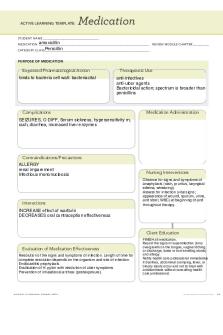ATI Medication Template Phenytoin PDF

| Title | ATI Medication Template Phenytoin |
|---|---|
| Author | Celena Robison |
| Course | Clinical: RN Health Care Concepts IV |
| Institution | San Antonio College |
| Pages | 1 |
| File Size | 116.7 KB |
| File Type | |
| Total Downloads | 51 |
| Total Views | 175 |
Summary
ATI Medication Template Phenytoin...
Description
ACTIVE LEARNING TEMPLATE:
Medication
STUDENT NAME _____________________________________
CH.13
MEDICATION Phenytoin __________________________________________________________________________ REVIEW MODULE CHAPTER ___________
(AEDs) CATEGORY CLASS Antiepileptics ______________________________________________________________________ PURPOSE OF MEDICATION
Expected Pharmacological Action AEDs control seizure disorders by various mechanisms. *Slowing the entrance of sodium and calcium back into the neuron, thus extending the tim takes for the nerve to return to its active state and slows the frequency of neuron firing. *Suppressing neuronal firing, which decreases seizure activity and prevents propagation o seizure activity into other areas of the brain. *Decreasing seizure activity by enhancing the inhibitory effects of gamma butyric acid (GABA).
Therapeutic Use Phenytoin is a hydantoin medication that suppresses partial seizure and primary generalized seizure activity in the affected neurons.
Complications CNS effects:
Contraindications/Precautions
Medication Administration PO *Give divided doses with or after meals to decrease adverse GI reactions. - For chewable tablets, patient may chew thoroughly before swallowing or may swallow whole. - Shake suspension well before use. - Administer dose using a calibrated oral dosing syringe. - Different oral forms aren’t interchangeable. - Don’t crush or allow patient to chew extended-release capsules. - For oral suspension, withhold enteral feedings for 1 hour before and 1 hour after giving drug. IV - Clear tubing with NSS. Use only clear solution for injection. A slight yellow color is acceptable. - To give as an infusion, dilute in NSS to a final concentration of phenytoin sodium in the solution of no less than 5 mg/mL. Begin infusion immediately after mixture has been prepared. Infusion must be completed within 1 to 4 hours. - Infusion must begin within 1 hour after preparation and should run through an in-line filter. - Check patency of catheter before giving. - Monitor site for extravasation because it can cause severe tissue damage. - Black Box Warning: Drug must be administered slowly. In adults, don’t exceed 50 mg/minute IV. In children, administer drug at a rate not exceeding 1 to 3 mg/kg/minute or 50 mg/minute, whichever is slower because of the risk of severe hypotension and cardiac arrhythmias. - Follow each injection with injection of sterile NSS through the same needle or catheter. - If possible, don’t give by IV push into veins on back of hand to avoid purple glove syndrome. Inject into larger veins or central venous catheter, if available.
Pregnancy
Nursing Interventions Phenytoin causes a decrease in the effects of orals contraceptives, warfarin, and glucocorticoids due to stimulation of hepatic medication-metabolizing enzymes.
Interactions Phenytoin causes a decrease in the effects of orals contraceptives, warfarin, and glucocorticoids due to stimulation of hepatic medication-metabolizing enzymes.
Client Education Evaluation of Medication Effectiveness Depending on therapeutic intent, effectiveness is evidence by: *Absence or decreased occurrence of seizures. *Ability to perform ADLs. *Absence of injury.
ACTIVE LEARNING TEMPLATES
*Monitoring therapeutic plasma levels is recommended as prescribed by the provider. ● Monitor therapeutic plasma levels for medications prescribed and be aware of therapeutic levels for each medication. Notify the provider of results. ● If taking antiepileptic medications, treatment provides for control of seizures, not cure of disorder. ● Encourage the client to keep a seizure frequency diary to monitor effectiveness of therapy. ● Take medications as prescribed and do not stop medications without consulting the provider. Sudden cessation of medication can trigger seizures. ● Avoid activities that require alertness (driving, operating heavy machinery) until seizures are fully controlled and medication effects are known. ● If traveling, carry extra medication to avoid interruption of treatment. ● If of childbearing age, avoid pregnancy, because medications can cause birth defects and congenital abnormalities. ● Phenytoin doses must be individualized. Dosing usually starts twice a day and can be switched to once-a-day dosing with an extended-release form when maintenance dose has been established. ● Phenytoin has a narrow therapeutic range, and strict adherence to the medication regimen is imperative to prevent toxicity or therapeutic failure. ● Do not use phenobarbital, carbamazepine, topiramate, oxcarbazepine, or pregabalin while breastfeeding. If taking phenytoin, valproic acid, or lamotrigine, talk to the provider to weigh the risks and benefits of breastfeeding while taking the medication....
Similar Free PDFs

ATI Warfarin Medication Template
- 1 Pages

ATI Medication Template Cymbalta
- 1 Pages

Lithium Medication ATI template
- 1 Pages
Popular Institutions
- Tinajero National High School - Annex
- Politeknik Caltex Riau
- Yokohama City University
- SGT University
- University of Al-Qadisiyah
- Divine Word College of Vigan
- Techniek College Rotterdam
- Universidade de Santiago
- Universiti Teknologi MARA Cawangan Johor Kampus Pasir Gudang
- Poltekkes Kemenkes Yogyakarta
- Baguio City National High School
- Colegio san marcos
- preparatoria uno
- Centro de Bachillerato Tecnológico Industrial y de Servicios No. 107
- Dalian Maritime University
- Quang Trung Secondary School
- Colegio Tecnológico en Informática
- Corporación Regional de Educación Superior
- Grupo CEDVA
- Dar Al Uloom University
- Centro de Estudios Preuniversitarios de la Universidad Nacional de Ingeniería
- 上智大学
- Aakash International School, Nuna Majara
- San Felipe Neri Catholic School
- Kang Chiao International School - New Taipei City
- Misamis Occidental National High School
- Institución Educativa Escuela Normal Juan Ladrilleros
- Kolehiyo ng Pantukan
- Batanes State College
- Instituto Continental
- Sekolah Menengah Kejuruan Kesehatan Kaltara (Tarakan)
- Colegio de La Inmaculada Concepcion - Cebu












